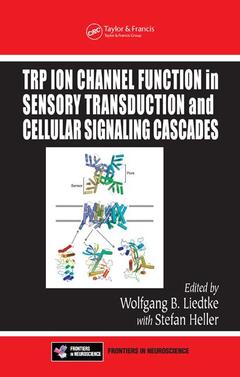TRP Ion Channel Function in Sensory Transduction and Cellular Signaling Cascades Frontiers in Neuroscience Series
Coordonnateur : Liedtke, MD, PH.D. Wolfgang B.

Since the first TRP ion channel was discovered in Drosophila melanogaster in 1989, the progress made in this area of signaling research has yielded findings that offer the potential to dramatically impact human health and wellness. Involved in gateway activity for all five of our senses, TRP channels have been shown to respond to a wide range of stimuli from both within and outside the cell body. How we sense heat and cold, how we taste food, how eggs are fertilized, how the heart expands and contracts is each dependent on the function of these channels.
While no single book could possibly cover all the research being undertaken, TRP Ion Channel Function in Sensory Transduction and Cellular Signaling Cascades presents the most advanced compilation of work in this area to date. All 31 chapters are written by international pioneers working at the vanguard of TRP ion channel research. They explain much about the pivotal function and behavior of these channels, which are most exquisitely tuned to their specific tasks, and delve into how researchers are putting this knowledge to use in the development of novel pharmaceuticals, which may well prove effective in ameliorating treatment-resistant conditions including cancer, heart disease, inflammation, and immune system dysfunctions.
Individual chapters shed light on selected topics of interest in the TRP arena, such as signal transduction in axonal path-finding, and in vascular, renal, and auditory functions, as well as pain. The text also covers subjects as diverse as mating and fertilization, inflammatory pain, and mechanisms of pheromone detection in mammals. While the book presents much new insight and explores findings that will be of interest to those involved with advanced research, it also includes significant background material for those looking to familiarize themselves with this exceptionally promising path of inquiry.
Date de parution : 09-2006
Ouvrage de 384 p.
15.6x23.4 cm
Thèmes de TRP Ion Channel Function in Sensory Transduction and... :
Mots-clés :
Channel Trp; trpv; TRPC Channel; neuron; TRPV6 Channel; trpc; TRPA1; channels; TRPM8; trpv2; Trp Channel; activation; TRPV1 Activation; plasma; membrane; TRPV4 Expression; ruthenium; TRPC4 Channels; red; TRPC Protein; TRPV4 Function; TRPV1 Activator; CRAC Channel; TRPC3 Channel; HEK293 Cell; Trp Superfamily; TRPM8 Activation; TRPA1 Channel; Mechanosensitive Channel; Sensory Neurons; Ankyrin Repeat Domain; TRPV1 Agonist; TRPV Subfamily



